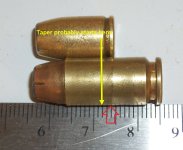Had problems with bullet setback in a .40 HP, which has an unusually stout recoil spring. These were factory power 155 plated bullets. Immediately stopped using any Rem brass, and segregated all the other .40 brass by brand. Bought Lee undersize die (for additional neck sizing step), general mouth expander and Redding comp seater so could seat bullets straight with min to no setback. Also use a very slight LFC, just to insure no flare left on case mouth. No more set back. Have a preference for the Win or Fed brass, but keep them segregated.
Have never tried canneluring brass, but have used corbin tool to cannelure bullets. Have noticed over the years that some manufactures actually crimp their case mouths into the bullets slightly for semi auto rounds. And it appears some manufacturers have started canneluring/crimping their semi auto hp bullets.

